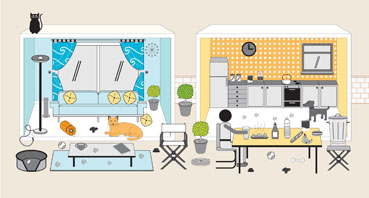All you need to know about pet-proofing your home

Tired of chewed furniture, dirty upholstery and discovering little surprises? Here's our quick guide to limiting your pet's impact on your home.
How to stop kittens shredding the curtains
Loop curtains out of leaping range (but avoid tie-back cords, which can pose a risk of pet strangulation). Re-channel their energy with toy mice and ping-pong balls to bat, and a tunnel of cardboard boxes to race through. Fishing-rod cat toys are a great way to play with a kitten without getting scratched.
Pets vs. pot plants
If you're having problems with your pet leaving little surprises in the compost of your pot plants, place cobbles on the surface. If your pet nibbles leaves, move plants to a higher level. Avoid lilies, poinsettias, azaleas, amaryllis and ivy, which can be poisonous, and double-check any other plants with your vet. Most cats love to nibble cat grass, which is available from garden centres.
Bin there, done that
Struggling to stop them from bin-diving for scraps? Swap flip-top or pedal bins for an under-the-sink style that can be secured with a childproof latch. If your dog can't resist getting under your feet when you're cooking, a child- or dog-gate will keep the Sunday roast from becoming the dog's dinner.
Caught short?
Little presents in dark corners or under the kitchen table can be a nasty surprise, especially if you have young kids. With cats, this could be a sign that the litter tray is in an exposed place or needs changing. Puppies need regular toilet breaks. Get into the habit of taking your puppy out to the same spot after meals, play or any other excitement, such as visitors arriving. Always praise him for toileting outside.
Shocking stuff
Dangling electrical cords can tempt inquisitive kittens and puppies, risking knocked-over lamps and, even worse, a nasty shock for your pet. Tuck away leads with a cable tidy so that pets can't get tangled up in them. To prevent the risk of an electric shock, consider installing an RCD unit (a type of circuit-breaker) or try cable protectors for persistent chewers.
Scratch 'n' sniff
The problem: shredded sofa arms and sofa spoiled by hair or muddy paw prints.
The solution: if a sofa arm becomes a target for cat scratching, put a scratching post there, then very gradually move it to a better spot. If your muddy or moulting pet loves jumping on the sofa, cover the sofa with an old throw or provide your pet with a comfy bed in the lounge, and consistently reward it when it settles there instead.
Feline fragrance
Spraying on carpets, walls or soft furnishings can be a complex problem, often due to a cat feeling threatened or anxious. Triggers can be anything from other neighbourhood cats to the arrival of a baby. A Feliway diffuser (from your vet) can help, but the cause of the spraying needs to be addressed.
Chew on this
Chewed slippers, remote controls, furniture and more - they're all fair game to a bored puppy or dog. Never leave your adult dog for more than four hours at a time, and rotate a wide range of safe chew toys. Try dental chews or pigs' ears. It is also important to remember that a puppy can continue to chew well into adolescence as its adult teeth settle in.
Dig for victory
Wrecked lawn and devastated flowerbeds? Your dog is only doing what comes naturally - having a really good, dirty dig - so let him express his urge in a sectioned-off sand or earth pit. Bury treats and chewy toys in it and it'll soon appeal more than flowerbeds. However, cats love to toilet in fine-grain sand or soil, so cover up any sandpit overnight.
Drinking problems?
If telltale paw prints are revealing that your pet drinks from the bath, sink or loo, make sure your cat or dog has their own source of fresh drinking water that they can easily get to. To deter bathroom visits, keep the toilet lid down and the bathroom door shut. While you're at it, check no windows around the house are left wide open when you go out - an adventurous pet could escape or fall from one.
By Jo Leevers, journalist (and animal-lover)
Originally published in issue 4 of PetPeople, the Petplan customer magazine

